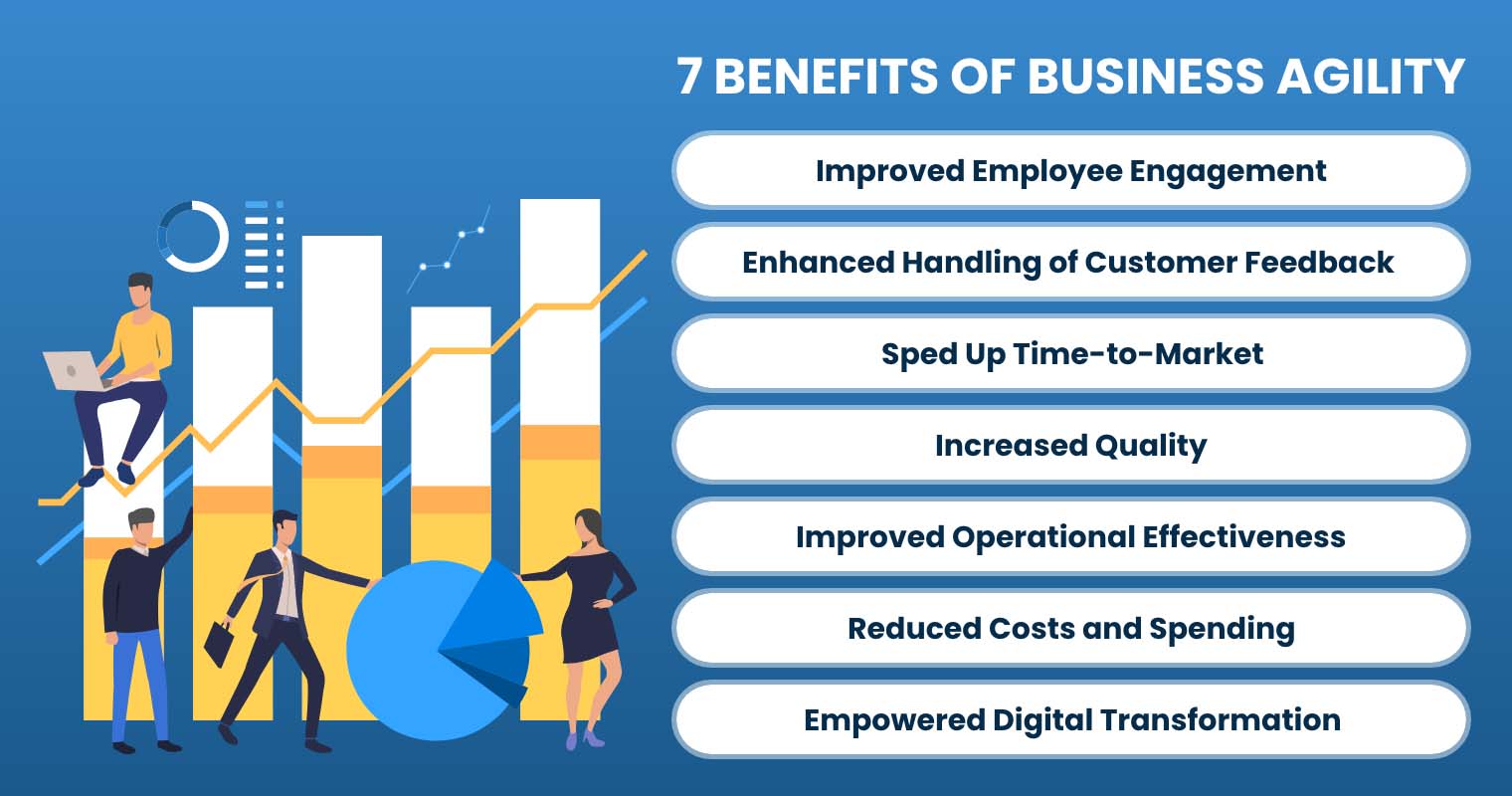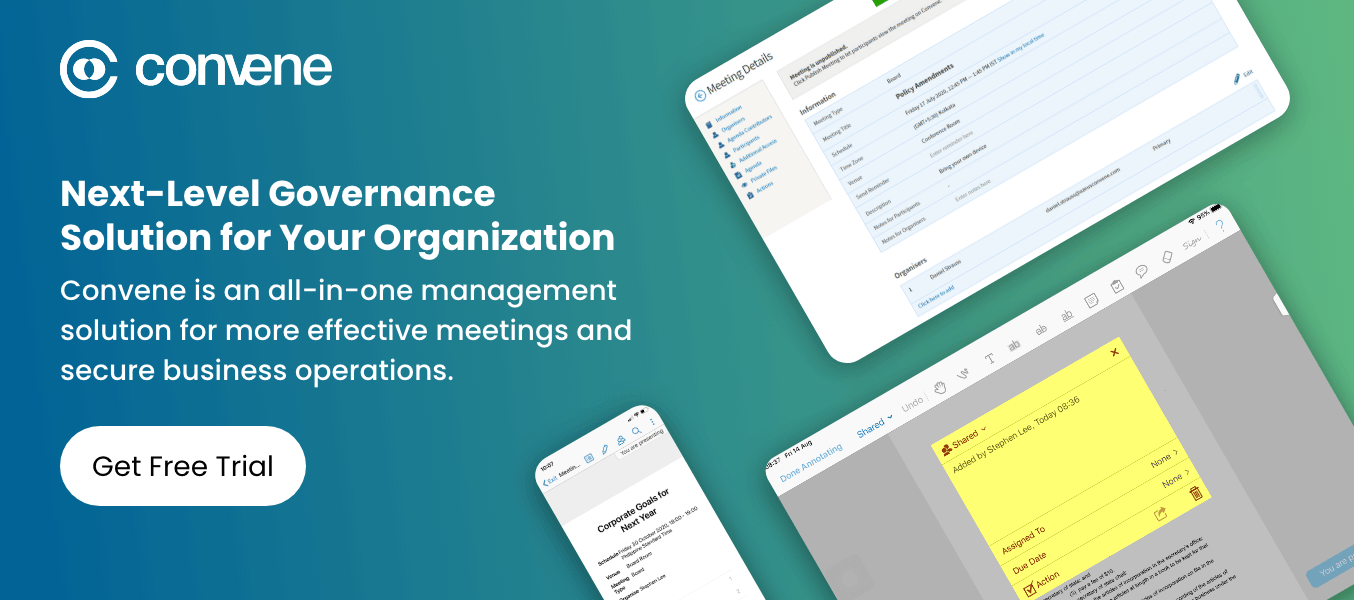Digitalization, sustainability, and changing customer demands are the top factors that cause market shifts in the global economy. In efforts to maintain their relevance and competitiveness, some businesses have adapted enterprise agility.
Agility was first used in software engineering; it refers to the ability to respond decisively and quickly to change. After discovering how agile methods can enhance productivity and efficiency in businesses, they began implementing them into their operations. Many switched from traditional methods and chose the adaptive approach of enterprise agility, which ultimately led to agile transformations.
Explore the impacts of enterprise agility on traditional workplace practices. Learn what to consider and how to get prepared before starting an agile transformation.
What is enterprise agility?
Enterprise agility describes a company’s ability to swiftly adapt to its business environment based on feedback from direct stakeholders (e.g., customers, investors) and changes in market demands. Agile enterprises are responsive to evolving customer needs, swift technological advances, and growing sustainability concerns without sacrificing profitability and business continuity.
Also referred to as business agility or organizational agility, the enterprise agility framework applies a holistic approach to business development putting high regard to collaboration, alignment, speed, balance, and growth mindset. Enterprise agile organizations comprise cross-functional, self-sufficient teams that collaborate efficiently, maximizing productivity using fewer resources. Cross-functional teams have all the necessary skills to complete a task, project, or product.
The production process in agile enterprises is based on iterations: cycles of work ending with a working version of a product. Teams improve the product based on feedback collected with every new iteration. To ensure that the product provides as much value to the customer as possible, agile promotes the collection of feedback from users.
What are the benefits of business agility?

Introducing agility to business procedures pushes teams to seek out innovative, adaptable, and effective ways to optimize workflow, thereby streamlining tasks, boosting employee engagement, and increasing productivity. Apart from these, here are the top benefits that you can reap from a well-implemented enterprise business agility:
1. Improved Employee Engagement
At the core of agile principles lies the spirit of collaboration. Agile teams have a clear view of how their work fits into the bigger picture—this lets team members collaborate more creatively and purposefully.
When all team actions have a defined purpose, it creates a sense of autonomy and ownership. Ownership and a broader project context enrich the job experience: employees are empowered to contribute and solve problems. A team’s tangible impact on all aspects of a project enhances productivity and promotes innovation.
When there’s a purpose and meaning ingrained in every employee’s action, motivation and engagement soar.
2. Enhanced Handling of Customer Feedback
In the enterprise agile methodology, the customer and their needs are placed at the center of company operations.
This mindset builds a unified, company-wide mission statement that guides all departments toward the same goal—to provide value to the customer. An agile mindset, lets teams align on customer value propositions. This decreases the number of handovers and increases accountability and transparency directly translating into customer satisfaction.
Cross-functional teams can target specific product offerings or outputs and deliver seamless experiences to different audiences. The self-sufficient, cross-functional team setup boosts efficiency and reduces time-to-market. Agile teams can decrease the response time to the competitors’ offerings.
3. Sped Up Time-to-Market
The cross-functional character of agile teams lets them complete business objectives on their own, without multiple handovers to different departments. In an agile structure, where hierarchy is replaced with purpose-based teams, productivity improves significantly.
Product owners in agile teams have autonomy regarding the scope, timing, and budget of a project. This works to eliminate an otherwise lengthy approval period. When departmental silos and handovers are removed, the time to turn concepts into products drops, speeding up product releases.
4. Increased Quality of Work
Accepting and responding to stakeholder feedback forms a cycle of growth and development within an agile enterprise. Being agile involves periodic evaluations of process intricacies across departments and teams. This process allows teams to discover opportunities that will guide them to deliver superior products or services.
Such forward-thinking strategy is usually reflected in proactive and result-driven customer service, intuitive software, and optimized finance management. Agile enterprises adopt iteration practices for continuous improvement. This small and progressive approach creates greater results over time because it is grounded on testing and user feedback.
5. Improved Operational Effectiveness
Agile teams can bolster overall operational efficiency using OKRs (Objectives and Key Results), which are measurable deliverables of high-level initiatives. For example, company objectives like high revenues and increased profitability translate into specific goals, such as entering new markets or raising gross profit margins.
Agile setups enable quick adjustments and pivots when glitches or bottlenecks arise. Purpose-based teams in agile organizations minimize handovers between departments, ensuring seamless operations and rapid adaptation to market demands.
6. Reduced Costs and Spending
The combined benefits of the agile approach offer numerous cost-saving and growth opportunities for businesses.
For example, by restructuring teams to be self-sufficient and cross-functional instead of working in the traditional hierarchical model, companies can delegate the employees left after reducing management layers to new and innovative tasks that facilitate company growth. When teams become better at utilizing and managing resources, cost-saving opportunities will quickly emerge.
7. Empowered Digital Transformation
Digital transformation refers to the upgrade of business processes from legacy systems to automation. Implementing an agile approach to digitalization makes businesses take on a gradual process of test-and-learn strategy. This method involves shorter iterations with evaluations after every phase. With such a systematic process, businesses can set up a dynamic cycle of improvements and alterations that adapt to their situation.
How to implement enterprise agility in business?

The agile approach covers multiple aspects of an organization, from structure and business strategy to business processes and employees. Agile principles work because of their highly collaborative nature and direct project ownership of teams—the work doesn’t migrate from department to department.
Enterprise agility transformation calls for a complete overhaul of the work mindset. Departmental silos have to be broken down to facilitate collaboration and productivity.
Here are the basic steps necessary to create an agile team, department, or company.
1. Identify adoption challenges
The success of implementing agile can be predicted by the preparedness of an organization for possible adoption challenges. Because every company is unique, the response to agile methodologies could also vary. For example, smaller businesses may be more receptive to the agile mindset because of their loose hierarchical structure, whereas larger businesses initially may show strong resistance because of their strong sense of hierarchy deeply rooted in traditional systems.
When implementing enterprise agility, organizations should perform a feasibility analysis on the strengths, weaknesses, and requirements of teams to help in forming a contingency plan in case resistance starts. Practicing foresight and an agile mentality from the onset avoids teams from the perils of ill-preparedness, thus minimizing business disruption during shifts towards enterprise agility.
2. Transform the company culture
Adopting enterprise agility demands more than a shift in processes, but also in the company culture. Senior leaders should develop initiatives to promote the four pillars of the agile mindset in the workplace: respect for all team members, optimized and sustainable flow, encourage team innovation, and focus on improvement.
Developing a complete understanding of the principles, promises, and guidelines of enterprise agility helps to empower employees. When teams understand the basic concepts of enterprise agility, it encourages openness to growth opportunities, embracing new ideas, and assuming greater ownership of their work.
3. Optimize business processes with technology solutions
Aligning business processes with agile methodologies is a crucial step. Businesses are proven to experience higher-quality outcomes in day-to-day operations with enterprise agility. To make the implementation more impactful, organizations should not miss using technological solutions such as digital workplaces, cloud services, and automation.
Business process management software is a tool that helps align teams with the business goals as it evolves. It defines task steps, maps out processes, and streamlines operations. Other technologies that can be used in agile implementation are artificial intelligence, automated tools for marketing, logistics software, and machine learning.
4. Invest in training and development
Attending comprehensive training programs gives employees well-rounded knowledge that prepares them for agility. They must be exposed to learning enterprise agility concepts and workshops for collaboration in agile systems.
Solid training backgrounds promote a culture of continuous learning and growth in every employee. More importantly, training programs empower each employee to grow professionally and motivate them to take an active role in the adoption of enterprise business agility.
Note: Initially, the benefits of agile transformation will take longer to appear. It takes some time for the newly agile teams to adjust to the new ways of working.
What are the considerations for going agile?
Embarking on an agile transformation is not without its challenges and may require several years of work to be fully adaptive. Here are the top considerations organizations must check before going agile:
- Leader Determination: Because the switch to enterprise agility requires a complete overhaul of the known project management strategies, determination to stick to agile principles is paramount.
- Complete Adoption and Restructuring: There are no half measures in the agile approach. If the transformation is incomplete, the teams will underperform. The company-wide understanding of agile principles and transforming operational effectiveness is critical to its successful implementation.
- Highly Motivated Employees: Leaders are responsible for nurturing agile culture within teams and instilling agile principles among team members. However, highly motivated employees are key. There’s no place for mediocrity in engagement.
How should businesses measure their enterprise agility?
The effects of enterprise agility transformation can be measured by analyzing the value delivered by newly agile teams or comparing the results with the former setup. There are two considerations here.
If you are starting to deploy the agile approach, you can use the data before the transformation to measure agility. However, this approach can be flawed as agile teams need time to adjust and deliver the expected value. Moreover, measuring agile transformation results using traditional metrics often fails because of the highly flexible nature of agile teams.
Instead, you can establish baselines as the newly agile teams begin to produce output and then measure the desired metric as per that team’s deliverable. In this method, OKRs are highly useful, especially those developed for specific teams.
Frequently Asked Questions About Enterprise Agility

Since the business agility definition has been thoroughly explained in the previous sections, let’s explore the top FAQs on enterprise agility to learn more about its characteristics.
What are the primary obstacles to implementing enterprise agility in a traditional organization?
When an organization pursues agile, it commonly encounters the following challenges:
- Shift in company culture and mindset: Senior leaders should take the lead in providing continuous training to employees on agile learning. The long-term success of an agile transformation is dependent on the shared understanding that improvement, change, and learning are life-long processes. A lack of understanding in employees will eventually become a challenge due to unmet targets which can hinder the implementation if not addressed proactively.
- Resistance to the new method: Traditional or waterfall project management involves upfront planning and hierarchical structures. On the contrary, agile project management promotes adaptive planning through iterative development and collaboration. Overcoming organizational resistance to change from traditional to agile is a major challenge in agile transformation. This resistance is often fueled by discomfort and instability associated with moving away from familiar processes and roles.
- Unclear vision and objectives for the company: A lack of clearly communicated vision and objectives can lead to issues in an agile transformation. When teams do not grasp the goals of an organization, they might work towards different objectives. Senior leaders can use agile roadmaps to make teams understand the entire vision and objectives of the transformation. Agile roadmaps show the details of the entire transformation plan and the timelines of targets so teams can visualize how their contributions fit into the bigger picture.
Is enterprise agility only applicable to the IT industry?
Agile principles apply to a variety of industries despite being first developed in software development. The transformative framework is adaptable to any business that wants to restructure its systems.
For example, a manufacturer seeking to optimize its product development process can use agility to revamp its internal operations. With the implementation of new agile systems, the turnaround from the ideation phase to the creation of prototypes will be much faster. The improved workflow made possible by agile makes the overall productivity and efficiency of teams higher.
Can small businesses also embrace enterprise agility?
Not only can small businesses benefit from enterprise agility, but they also have an advantage over larger companies. Implementing agility in smaller businesses is typically faster and simpler because of their relatively narrower scope; resulting in them becoming more risk-responsive, relevant, and competitive.
How long does it take to implement enterprise agility successfully?
Agile transformation often takes a year or more of consistent training and development. Steadfast support from senior leaders during the transformation, in terms of commitment, time, and resources, is a significant contributing factor to its success.
Companies can engage an agile champion who can assist in devising a comprehensive transformation plan to perform a smoother transformation. The agile champion will be the assigned point of contact for teams who are ready to address any questions that arise during the process toward true agility.
Does enterprise agility require significant investments in technology?
Technology is crucial for the success of enterprise agility adaptation. This connection is attributable to the essence of enterprise agility; to empower organizations to rapidly adapt to market and environmental changes in productive and cost-effective ways.
According to a PWC report, 83% of agile businesses use technological solutions such as cloud services and virtual architecture. Companies were able to scale their business rapidly and shift directions as necessary with the help of these technologies.
Enhance Agility and Board Effectiveness with Convene’s Board Management Technology

It has been observed in recent years that traditional approaches have growing limitations. Taking advantage of feedback and harnessing the power of modern software and technologies for consistent refinement of processes creates a dynamic and efficient operational environment in businesses.
The use of the right technology in organizations makes them digitally agile. Digital solutions like Convene board portal allow executives to remotely meet from a secure and centralized platform. It helps executives and business leaders embody agility by empowering them with powerful features to navigate the complexities of modern corporate governance and digitalization.
Get in touch with our Convene team to begin your journey toward corporate governance agility in the future.
Audrey is a Content Marketing Specialist at Convene, in charge of managing the production of quality content on the company’s website. A communication major keen on marketing, Audrey has been constantly seeking approaches to create tailored content—may it be about governance, digitalization, boards, or meetings—fit for the stakeholders. When not strategizing on the next ebook to produce, Audrey finds solitude in reading make-you-ugly-cry novels and listening to self-improvement podcasts.










